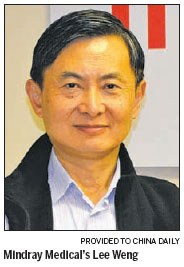Mindray eyes medical-device leadership
Updated: 2012-12-14 14:45
By Deng Yu in Seattle (China Daily)
|
||||||||

Chinese medical-device maker Mindray Medical International Ltd recently displayed enhancements to its DC-8 ultrasound system at an industry conference in Chicago, part of a program to hone the company's competitive edge.
The new version of the DC-8, presented in late November at the annual conference of the Radiological Society of North America, offers improved performance for a variety of clinical uses in diagnostic imaging. It's an example, executives say, of the effort to make Mindray a leading provider of "health care within reach" of customers.
"Mindray continues to innovate and provide unsurpassed economic value to our customers," said Michael Thompson, vice-president of ultrasound sales for subsidiary Mindray North America.
In Seattle, where the company's first overseas research-and-development center opened in 2006, General Manager Lee Weng said his team is committed to delivering high-quality medical devices to the US market. The company exports to 190 destinations, and about half its revenue is from sales abroad.
Mindray was founded in 1991 in Shenzhen, now the high-tech and manufacturing hub of southern China. It initially functioned as a trading company that sold foreign-made medical equipment in the Chinese market.
But company founders Xu Huang and Li Xiting, both of whom had worked as engineers in the 1980s at a State-owned maker of medical devices - had ambitions of turning their company into a designer, manufacturer and marketer of its own wares.
In 1992, the company began investing heavily in R&D, leading to development of its first patient-monitoring device. It also sought entry to mature markets such as the US and Europe, using its Seattle R&D site as the springboard for expansion.
"Mindray dedicated itself to making sure its products met high standards in the US at that time," Lee said. "Its long-term commitment to research and development affirmed my decision to join the company.
"We chose Seattle because it's the hub of ultrasound innovation and provides an outstanding talent pool of experts and engineers," he said.
Mindray has traded its stock in the form of American depositary shares on the New York Stock Exchange since an initial public offering in 2006 that raised $311 million. The shares have gained 37 percent this year and recently traded about $2 below the top of their 52-week range ($36.36).
In early November, the company said it expects net revenue for 2012 to be at least 18 percent higher than last year's $881 million. It also forecast net income - not calculated according to generally accepted accounting principles - to increase at least 15 percent over non-GAAP net income of $186.3 million in 2011.
For the third quarter ended Sept 30, Mindray reported GAAP-calculated net income of $35.8 million, or 30 cents per ADS, on $257.1 million in revenue, fueled by strong sales in China and abroad (up 26 percent and 11.6 percent, respectively, from last year's third quarter).
Lee acknowledges international aversion to Chinese-made medical devices - he calls it "prevailing prejudice" - but said he has worked with ultrasound-technology experts in the US and engineering teams in China "to produce competitive and innovative products that meet and exceed customer expectations".
Having been president or vice-president of division Mindray Medical USA Corp from 2006 through last year, and continuing as manager of the Seattle R&D center, Lee stresses the need to design products with patients in mind, not to delight fellow engineers.
The Seattle R&D center, he said, "opens a window to our engineers and marketers in China. We learn technologies, customer expectations and marketing philosophies, all of which are good experience for our product and market development in China and other countries."
Because many of its products sold abroad have been certified by regulators in the European Union or by the US Food and Drug Administration, Mindray stands out from other Chinese device makers that don't have such "clearances". Today the company operates in three segments - patient monitoring and life support, in vitro diagnostic products and medical-imaging systems - and competes against the health care units of global players General Electric Co, Royal Philips Electronics NV and Siemens AG.
About 1,550 employees, a third of the work force, are engaged in R&D at facilities in six Chinese cities; Sweden; and New Jersey, Florida and Seattle. The company says it spends about 10 percent of annual revenue on R&D. The consistent investment provides for a pipeline that led to 13 new products in 2011.
A milestone in Mindray's US expansion was the $200 million acquisition of New Jersey-based Datascope Corp's patient-monitoring business in 2008.
"Datascope strengthened our product line in patient monitoring and provided good channels through which Mindray's R&D team learned more about customer needs in the United States and even other foreign markets."
lindadeng@chinadailyusa.com

 Relief reaches isolated village
Relief reaches isolated village
 Rainfall poses new threats to quake-hit region
Rainfall poses new threats to quake-hit region
 Funerals begin for Boston bombing victims
Funerals begin for Boston bombing victims
 Quake takeaway from China's Air Force
Quake takeaway from China's Air Force
 Obama celebrates young inventors at science fair
Obama celebrates young inventors at science fair
 Earth Day marked around the world
Earth Day marked around the world
 Volunteer team helping students find sense of normalcy
Volunteer team helping students find sense of normalcy
 Ethnic groups quick to join rescue efforts
Ethnic groups quick to join rescue efforts
Most Viewed
Editor's Picks

|

|

|

|

|

|
Today's Top News
Health new priority for quake zone
Xi meets US top military officer
Japan's boats driven out of Diaoyu
China mulls online shopping legislation
Bird flu death toll rises to 22
Putin appoints new ambassador to China
Japanese ships blocked from Diaoyu Islands
Inspired by Guan, more Chinese pick up golf
US Weekly

|

|







